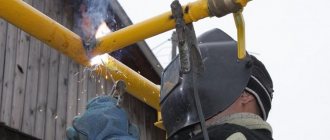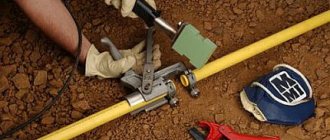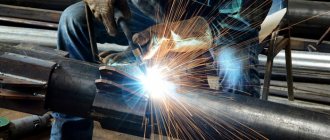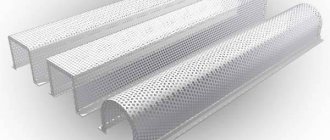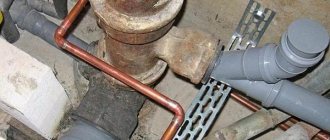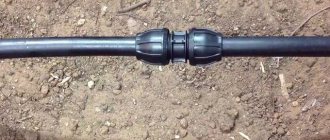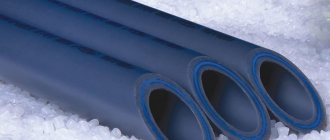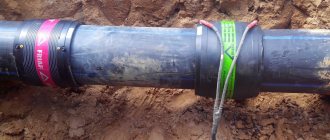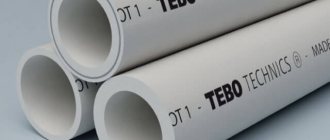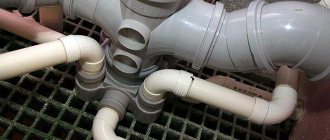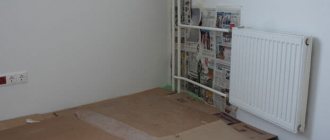We welcome our regular reader and bring to your attention an article about what welding of polyethylene pipes is - a very reliable method of connecting polyethylene pipelines.
When installing engineering systems in a house, connecting an estate to a cold water main, or laying a pressure sewer, inexpensive and practical polyethylene pipes are simply irreplaceable. For installation of pipelines in the ground and basements, polyethylene pipes are the best option in terms of price and technological qualities.
Polyethylene as a material for engineering systems is underestimated, although the advantages of PE pipelines are undeniable. Polyethylene products are absolutely harmless to humans, the material is chemically inert, durable and at the same time plastic, frost-resistant (withstands freezing with water). The disadvantages of polyethylene - instability to ultraviolet radiation and elevated temperatures - limit its use in the open air and for heating and hot water systems, but for laying in the ground polyethylene communications are almost ideal.
The flexibility of polyethylene pipes allows them to be laid without fittings at turns; the possibility of laying a single piece from the main to the metering unit in the house is also a big plus, because the financial savings are quite significant, and installation is much easier. The reliability and tightness of the seams make it possible to close and fill communications with a screed or false wall. A permanent connection does not require maintenance and regular inspections, like a detachable connection using collet couplings.
Methods for joining PE pipes
Polyethylene pipelines are installed in two ways: using fittings and flanges or several types of welding.
The connection requires special fittings (couplings and sockets) and without them. For pipes with a wall thickness less than 4.5 (diameters 50-110 mm), welding using fittings is used; for larger pipes with a thicker wall, butt welding and extruder welding are acceptable.
Diffusion
The diffusion method involves heating the ends to a viscous flow state. The prepared ends of the workpieces are joined and slightly compressed. Movable polymer molecules, under the influence of pressure, move into the parts being connected, mix, freeze in a new position when cooled, form new chemical bonds and ensure reliable adhesion of the pipes to each other.
It is incorrect to single out any welding method as diffusion. In fact, any welding of polyethylene is based on the process of diffusion of heated molecules.
Bell method
Not the most typical way. There are two options for implementation: using socket pipes and couplings. The method itself is reminiscent of welding polypropylene pipelines: the socket or coupling and the workpiece are heated using a soldering iron with a special nozzle. Then the workpiece is inserted into the socket of another pipe or coupling, fixed, pressed and held. Welding time – 20 seconds. If couplings are used, then the second pipe is soldered into the coupling in the same way. The cost of couplings is low; products with a socket are rarely found in stores. The connection is reliable and durable; small diameters can be welded.
Butt welding
This method is applicable to pipes with a wall thickness of more than 4.5–5 mm and a diameter of more than 50 mm.
Before carrying out work, cut off the polyethylene pipe strictly perpendicularly and thoroughly clean the ends. Then fix the pipe in the welding machine and carefully center it. A heater is inserted between the ends of the heating pipes, the pipes are pressed against it and heated until the ends soften. Then the heater is quickly removed, the ends are compressed in such a way that a small annular bead is formed at the junction - a flash. Cool the joint, then remove the machine. The work has its own subtleties; it requires two people.
Extruder welding
Extrusion - welding using a small apparatus from which molten polyethylene is extruded under pressure. Raw materials in the form of rods or granules are loaded into the extruder. Extrusion is used on pressure communications with a wall thickness of more than 6 mm, but it can also be used to patch non-pressure sewer pipelines with a thinner wall. The connection point is heated by a stream of hot air. It is advisable to chamfer the ends.
The quality of the seam is very high. The advantage of the method is that it is possible to weld an already laid polyethylene pipe without dismantling the pipeline.
Electrofusion welding
This is the most reliable, convenient and universal connection method. It can be used even in hard-to-reach places. But, unfortunately, it is also the most expensive - electric welding fittings are not cheap, and a welding machine also costs a lot. Welding with thermistor couplings is used from small to large diameter polyethylene pipelines.
During thermistor welding, polyethylene blanks are cut strictly perpendicular, carefully cleaned of burrs and dust, inserted into the coupling, and centered using special devices. The coupling has a heating element. It is connected to a special welding machine, current is supplied, the element heats up the coupling and the ends of the pipes, and they are welded.
With this type of welding, it is extremely important to keep the joint motionless until it cools completely.
Which way is better
Before choosing the best connection method, it is necessary to determine which one is applicable in a particular case, depending on the diameter of the pipeline.
The most reliable and universal method is welding using thermistor couplings. But couplings, especially large diameters, are expensive, expensive, and a welding machine (but you can rent one). Therefore, such welding is not very common when arranging a private home.
More often they are butt welded or using solder couplings. Butt welding is used on polyethylene pipes with large wall thicknesses; these are usually not used in private homes. Extrusion welding is not yet very widespread, mainly due to the little known nature of the method.
Socket welding (socket)
Connecting pipes using couplings and fittings is shown for HDPE pipes with a diameter of up to 63 mm. For these purposes, use a hand-held household soldering iron (welding machine). PE tubes of larger diameter are welded using an industrial mechanical apparatus.
Important: before performing socket welding, you must stock up on the required number of fittings plus a small reserve in case of defects in the work.
To carry out socket welding, in addition to a soldering iron, you need to prepare a pipe cutter and a tape measure.
READ ALSO: Marking of polypropylene pipes for heating - read the data correctly
The work of welding HDPE tubes is carried out in this way:
- The welding machine is installed on the platform and securely secured. Nozzles of the required diameter are attached to the heating surface using a special wrench. The welding machine is set to the desired temperature. For pipes made of PE (polyethylene) it should be 220-230 degrees.
- The parts prepared for welding are put on nozzles and held until the plastic is thoroughly heated. As a rule, this is 5-7 seconds.
- After the parts have warmed up, it is necessary to slowly but fully connect the two elements and hold them in this state for at least 10 seconds so that the fitting and pipe do not change their welded position.
- After such manipulations, the internal lumen of the pipe remains smooth and sealed, and the polymer processed by the welding machine forms a single whole.
Important: Excessive overheating of the pipes should be avoided. Otherwise, when connecting two elements, the plastic will simply fold into an accordion, which will disrupt both the internal lumen of the pipes and the quality of the connection.
Tip: after each welding procedure, be sure to clean off the melted polymer from the Teflon surface of the nozzles. Otherwise it will interfere with the next welding process. Moreover, you need to remove the plastic exclusively with a wooden spatula. This way you can keep the Teflon intact and unharmed. It is prohibited to remove cold plastic or metal objects.
Features of working with LDPE and HDPE
These two types of polyethylene differ slightly in their technical characteristics and parameters. The information is summarized in a table.
| Characteristic | PVD (PNP) | HDPE (PVP) |
| Melting point, °C | 103-110 | 125-132 |
| Softening temperature, °C | 100 | 120-125 |
| Rigidity | small | big |
| Flexibility | big | small |
| Fragility | small | more than PVD |
| Strength | average | high |
When welding, it should be taken into account that LDPE requires a lower temperature to melt than HDPE. HDPE has greater strength than LDPE.
Do-it-yourself welding of PE pipes
Welding polyethylene pipes at home is not too difficult and can be done with your own hands. The main problem is expensive equipment. In any case, it is worth renting rather than buying.
Before manipulation, it is necessary to cut the workpieces evenly and thoroughly clean and degrease the ends.
Required tools and materials
To weld polyethylene communications you will need pipes and possibly couplings.
List of required equipment:
- Pipe cutter is a device for cutting.
- It’s a good idea to use an electric trimmer to accurately align the ends of the pipes.
- For larger diameters it would be a good idea to use a chamfer.
- Socket welding machine. Structurally, it resembles a soldering machine for polypropylene.
- Corresponding nozzles.
- For end connections, a special centering machine and a heating element are used.
Stages of work
First, the pipes are cut at an angle of 90°, burrs are cleared, dust and chips are removed, and degreasing is carried out. It is more convenient to do this work with an electric trimmer.
Socket (socket) welding technology
Put the desired nozzle on the soldering iron and heat it for the time specified in the instructions. Then heat the coupling and pipe until the polyethylene softens and connect them. They give time for diffusion and polymerization - for about 20 seconds the compound cannot be touched. Then the second workpiece is connected to the coupling in the same way.
Butt connection
The workpieces are installed in the joining machine, fixed and carefully centered. Before soldering, you need to make sure that the longitudinal axes of the workpieces completely coincide. A heating element is inserted between the polyethylene blanks and held until the material softens. The heater is removed, the workpieces are quickly connected, and pressed with force until an annular bead is formed at the seam site. Stand until cooled.
Butt welding is not as simple as it seems at first glance and requires some experience.
Seam quality control
The reliability of the connection depends on the quality of the seam. The height of the burr bead during a butt connection must correspond to the table data.
There should be no cracks, pores or cavities near the rollers. The rollers must be the same around the entire circumference, the same height. The recess in the center should not fall below the surface of the pipes. The parts should not be offset from each other. If you solder a defect, the connection will have to be cut and redone.
Photos of defective butt joints:
Butt welding
You can also butt weld HDPE pipes with your own hands. Butt welding is performed using special equipment with a mechanical or hydraulic drive. Such a welding machine will allow you to join two elements of the tubes until they are completely and tightly connected. The most popular devices are those that have software control. Such equipment is characterized by full automation and the ability to control the welding process without operator intervention in terms of physical effort.
READ ALSO: Do-it-yourself water supply installation diagram for a dacha using HDPE pipes
Before doing the work yourself, you should select HDPE pipes with uniform technical characteristics. It is advisable to weld tubes even from the same batch. Since here the polymer is joined at the molecular level, this approach will make the weld more airtight and reliable.
Important: tubes with a wall thickness of at least 5 mm and a diameter exceeding 50 mm are suitable for butt welding.
The principle of butt welding is to heat the ends of the pipe on a special plate. After melting, the PE plate between the ends of the two pipes being welded is removed and the elements are mechanically compressed until the polymer is completely mixed and soldered. After which the pipes must be allowed to cool completely.
Important: when marking tubes and cutting them, it is worth taking into account the technical reduction in the length of the pipe after welding. In order to correctly calculate the length reduction factor, you can use the data below:
- So, for pipes with a cross-section of 20 mm, the melting length (welding depth) will be 14.5 mm;
- Elements 25 mm - 16 mm;
- For tubes with a diameter of 32 mm - 18 mm;
- For tubes with a cross section of 40 mm - 20 mm;
- Pipes with a diameter of 50 mm - 23 mm.
